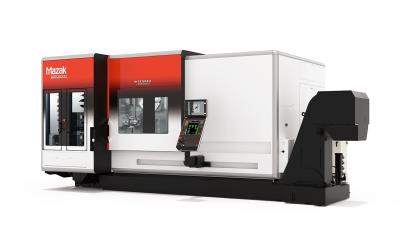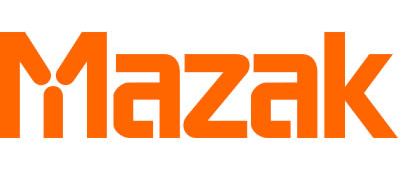
At Discover 2025, Mazak will unveil the new Integrex i-350S NEO multi-tasking machine that the company says can provide increased thermal stability and combines high-performance turning, milling and — for the first time — grinding operations along with advanced automation features.
During Discover, running Oct. 6-10 at the company's Florence, Kentucky facility, Mazak will demonstrate how manufacturers can finish parts to exacting tolerances and superior surface finishes with the ability to machine and grind in a single setup. As a result, shops also shorten lead times, reduce handling and improve process reliability.
The Integrex i-NEO Series of machines offers a wide range of automation solutions that meet diverse customer requirements. For applications utilizing overhead gantry loaders, unloaders or bar feed systems, the series provides a standard ergonomic front-mounted tool magazine that also ensures seamless integration with any automation strategy.
Mazak also offers the option to locate tool magazines at the rear of the machine along with optional retrofittable automatic front doors/robot interfaces that allow the machines to easily accommodate floor-mounted robots.
The Integrex i-350S NEO includes both a main and second turning spindle (S) and a milling spindle headstock for Done-in-One part production. The main spindle accommodates a 10" chuck and boasts a Y-axis stroke of 12" (304.8 mm) and X-axis stroke of 27" (685.8 mm) for a maximum part diameter capacity of 26.38" (670 mm).
Both the main and second turning spindles operate at 4,000 rpm, while the compact milling spindle comes standard as 12,000 rpm (24 hp/22 kW) and 20,000 rpm (24 hp/22 kW) as optional. The machine processes parts up to 59.80" (1519 mm) long with a 1500U-style bed and up to 98" (2489.2 mm) with a 2500U bed.
The Integrex i-350S and i-350ST model NEO Series machines incorporate the latest Mazak Mazatrol SmoothAi CNC control technology. For fully optimized machining operations, the AI-powered technologies within the new Mazatrol SmoothAi control make for fast and easy programming as well as controlled spindle speed for reduced vibration and greater machine thermal stability.
These Mazak AI-powered technologies include Solid Mazatrol that allows users to automatically generate programs from 3D part models; Smooth Ai Spindle that automatically optimizes spindle speed based on sensor feedback to minimize machining vibration for superior part surface finishes; and Ai Thermal Shield that adapts to and learns from environmental changes to control the effects of heat on machining accuracy.
In addition to Smooth Technology solutions and control functions, the control also provides access to Mazak’s Mazatrol TWINS software, which allows shops to create synchronized digital twins of real machines on their shop floors. The digital twin’s software solutions provide highly efficient machine operation through Smooth Project Manager, whichthe company ensures efficient job setups, and Smooth CAM Ai for an open and interactive interface for CAD/CAM software packages.
Contact Details
Related Glossary Terms
- chuck
chuck
Workholding device that affixes to a mill, lathe or drill-press spindle. It holds a tool or workpiece by one end, allowing it to be rotated. May also be fitted to the machine table to hold a workpiece. Two or more adjustable jaws actually hold the tool or part. May be actuated manually, pneumatically, hydraulically or electrically. See collet.
- computer numerical control ( CNC)
computer numerical control ( CNC)
Microprocessor-based controller dedicated to a machine tool that permits the creation or modification of parts. Programmed numerical control activates the machine’s servos and spindle drives and controls the various machining operations. See DNC, direct numerical control; NC, numerical control.
- computer-aided manufacturing ( CAM)
computer-aided manufacturing ( CAM)
Use of computers to control machining and manufacturing processes.
- feed
feed
Rate of change of position of the tool as a whole, relative to the workpiece while cutting.
- gang cutting ( milling)
gang cutting ( milling)
Machining with several cutters mounted on a single arbor, generally for simultaneous cutting.
- grinding
grinding
Machining operation in which material is removed from the workpiece by a powered abrasive wheel, stone, belt, paste, sheet, compound, slurry, etc. Takes various forms: surface grinding (creates flat and/or squared surfaces); cylindrical grinding (for external cylindrical and tapered shapes, fillets, undercuts, etc.); centerless grinding; chamfering; thread and form grinding; tool and cutter grinding; offhand grinding; lapping and polishing (grinding with extremely fine grits to create ultrasmooth surfaces); honing; and disc grinding.
- milling
milling
Machining operation in which metal or other material is removed by applying power to a rotating cutter. In vertical milling, the cutting tool is mounted vertically on the spindle. In horizontal milling, the cutting tool is mounted horizontally, either directly on the spindle or on an arbor. Horizontal milling is further broken down into conventional milling, where the cutter rotates opposite the direction of feed, or “up” into the workpiece; and climb milling, where the cutter rotates in the direction of feed, or “down” into the workpiece. Milling operations include plane or surface milling, endmilling, facemilling, angle milling, form milling and profiling.
- turning
turning
Workpiece is held in a chuck, mounted on a face plate or secured between centers and rotated while a cutting tool, normally a single-point tool, is fed into it along its periphery or across its end or face. Takes the form of straight turning (cutting along the periphery of the workpiece); taper turning (creating a taper); step turning (turning different-size diameters on the same work); chamfering (beveling an edge or shoulder); facing (cutting on an end); turning threads (usually external but can be internal); roughing (high-volume metal removal); and finishing (final light cuts). Performed on lathes, turning centers, chucking machines, automatic screw machines and similar machines.

